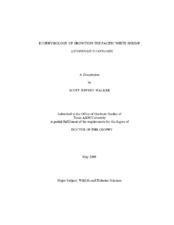| dc.description.abstract | Ecophysiological responses of Litopenaeus vannamei were evaluated as
functions of 1) salinity and animal size, 2) temperature and the animal's nutritive state,
and 3) dissolved-oxygen concentration and animal size. Growth rate, routine metabolic
rate, limiting oxygen concentration for routine metabolism, and marginal metabolic
scope were determined for L. vannamei maintained and tested at salinities of 2, 10, and
28 ppt, all at 28 C. Routine metabolic rate (RMR) was not demonstrably dependent on
salinity but decreased with increasing shrimp weight. Limiting oxygen concentration for
routine metabolism (LOCr) was independent of shrimp weight up to 9 g; but, for larger
shrimp, decreased with increasing weight. Marginal metabolic scope (MMS =
RMR/LOCr) also decreased with increasing shrimp weight and was independent of
salinity for shrimp weighing up to 9 g; but, like LOCr, MMS was dependent on salinity
for larger shrimp. Growth rate was significantly less at 2 ppt than at 10 or 28 ppt, which
gave similar growth rates. The effects of four temperatures (20, 24, 28, and 32 C) on
growth, RMR, LOCr, and MMS were examined for fed and starved L. vannamei. Routine metabolic rate increased with increased temperature both for fed and starved
shrimp. Marginal metabolic scope and growth appeared to be positively related and, at
20 C, seemed to induce a state of metabolic torpor. Data from the study of chronic
effects of hypoxia (~2 mg O2 L-1) vs. normoxia (> 5 mg O2 L-1) on ecophysiological
responses indicated that although low-DO environments can depress RMR and growth in
L. vannamei, animals grown under hypoxic and normoxic conditions did not differ in
their metabolic responses upon acute exposure to hypoxia, providing no evidence of
acclimation to hypoxia in L. vannamei.
Data from the above experiments were used to parameterize Ecophys.Shrimp, a
computer simulation model of shrimp growth in time-varying environmental regimes.
One unified model was able to simulate all my experiments; and, with only minimal
adjustment of the model parameter MMSO, it also adequately simulated studies taken
from the literature. Thus, Ecophys.Shrimp seems capable of realistically representing
the ecophysiological dynamics of shrimp metabolism and growth in various culture
systems. | en |


